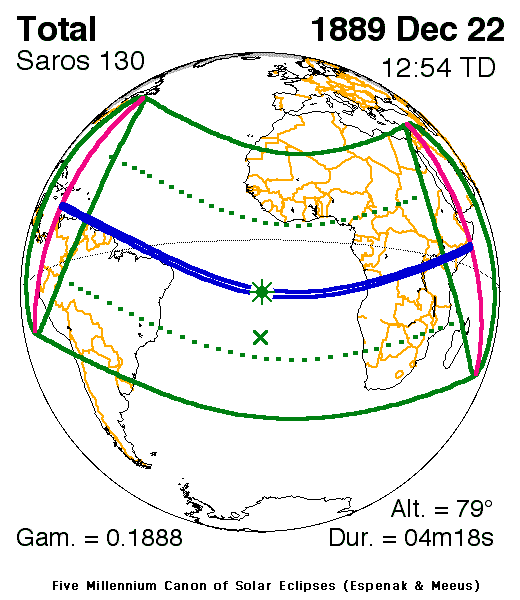A total solar eclipse occurred on December 22, 1889. A solar eclipse occurs when the Moon passes between Earth and the Sun, thereby totally or partly obscuring the image of the Sun for a viewer on Earth. A total solar eclipse occurs when the Moon's apparent diameter is larger than the Sun's, blocking all direct sunlight, turning day into darkness. Totality occurs in a narrow path across Earth's surface, with the partial solar eclipse visible over a surrounding region thousands of kilometres wide.It was visible from Cuba, to the coast of Brazil, and across southern Africa.
| Attributes | Values |
|---|
| rdfs:label
| - Eclissi solare del 22 dicembre 1889 (it)
- 1889년 12월 22일 일식 (ko)
- Solar eclipse of December 22, 1889 (en)
- 1889年12月22日日食 (zh)
|
| rdfs:comment
| - L'Eclissi solare del 22 dicembre 1889, di tipo totale, è un evento astronomico che avrà luogo il suddetto giorno con centralità attorno alle ore 12:54 UTC. L'evento è stato visibile da Cuba fino alla costa sud del Brasile e attraversando l'Atlantico ha percorso l'Africa meridionale sino al Golfo Persico. L'eclissi ha avuto un'ampiezza massima di 125 chilometri e una durata di 4 minuti e 18 secondi. L'eclissi del 22 dicembre 1889 divenne la terza eclissi solare nel 1889 e la 217ª nel XIX secolo. La precedente eclissi solare si è verificata il 28 giugno 1889, la seguente il 17 giugno 1890. (it)
- 1889년 12월 22일 일식은 달이 지구와 태양 사이를 지나면서 태양을 완전히 가리는 개기일식이다. 개기일식은 달의 시직경이 태양의 시직경보다 커서 태양을 다 가릴 수 있을 때 일어난다. 개기일식은 매우 좁은 지역에서만 관측 가능하며, 대부분의 다른 지역에서는 부분일식으로 관측된다. (ko)
- 1889年12月22日日食为一次在协调世界时1889年12月22日出現的日全食。該次日食食分為1.0449,食甚維持4分18秒。 (zh)
- A total solar eclipse occurred on December 22, 1889. A solar eclipse occurs when the Moon passes between Earth and the Sun, thereby totally or partly obscuring the image of the Sun for a viewer on Earth. A total solar eclipse occurs when the Moon's apparent diameter is larger than the Sun's, blocking all direct sunlight, turning day into darkness. Totality occurs in a narrow path across Earth's surface, with the partial solar eclipse visible over a surrounding region thousands of kilometres wide.It was visible from Cuba, to the coast of Brazil, and across southern Africa. (en)
|
| foaf:depiction
| |
| dcterms:subject
| |
| Wikipage page ID
| |
| Wikipage revision ID
| |
| Link from a Wikipage to another Wikipage
| |
| Link from a Wikipage to an external page
| |
| sameAs
| |
| dbp:wikiPageUsesTemplate
| |
| thumbnail
| |
| has abstract
| - A total solar eclipse occurred on December 22, 1889. A solar eclipse occurs when the Moon passes between Earth and the Sun, thereby totally or partly obscuring the image of the Sun for a viewer on Earth. A total solar eclipse occurs when the Moon's apparent diameter is larger than the Sun's, blocking all direct sunlight, turning day into darkness. Totality occurs in a narrow path across Earth's surface, with the partial solar eclipse visible over a surrounding region thousands of kilometres wide.It was visible from Cuba, to the coast of Brazil, and across southern Africa. The eclipse was the focus of a scientific expedition from the United States, led by David P. Todd of Amherst College and including a team of at least six. Among the members was E. J. Loomis from the American Ephemeris and Nautical Almanac office. It set sail October 16 on the USS Pensacola and set up the eclipse base camp in December, roughly 70 miles south of Luanda in Cape Ledo. Totality was completely obscured by cloud cover. The ship returned to New York after 242 days, with the expedition performing a variety of other scientific studies along the way. (en)
- L'Eclissi solare del 22 dicembre 1889, di tipo totale, è un evento astronomico che avrà luogo il suddetto giorno con centralità attorno alle ore 12:54 UTC. L'evento è stato visibile da Cuba fino alla costa sud del Brasile e attraversando l'Atlantico ha percorso l'Africa meridionale sino al Golfo Persico. L'eclissi ha avuto un'ampiezza massima di 125 chilometri e una durata di 4 minuti e 18 secondi. L'eclissi del 22 dicembre 1889 divenne la terza eclissi solare nel 1889 e la 217ª nel XIX secolo. La precedente eclissi solare si è verificata il 28 giugno 1889, la seguente il 17 giugno 1890. (it)
- 1889년 12월 22일 일식은 달이 지구와 태양 사이를 지나면서 태양을 완전히 가리는 개기일식이다. 개기일식은 달의 시직경이 태양의 시직경보다 커서 태양을 다 가릴 수 있을 때 일어난다. 개기일식은 매우 좁은 지역에서만 관측 가능하며, 대부분의 다른 지역에서는 부분일식으로 관측된다. (ko)
- 1889年12月22日日食为一次在协调世界时1889年12月22日出現的日全食。該次日食食分為1.0449,食甚維持4分18秒。 (zh)
|
| prov:wasDerivedFrom
| |
| page length (characters) of wiki page
| |
| foaf:isPrimaryTopicOf
| |
| is Link from a Wikipage to another Wikipage
of | |
| is foaf:primaryTopic
of | |


![[RDF Data]](/fct/images/sw-rdf-blue.png)



![[RDF Data]](/fct/images/sw-rdf-blue.png)





![[cxml]](/fct/images/cxml_doc.png)
![[csv]](/fct/images/csv_doc.png)
![[text]](/fct/images/ntriples_doc.png)
![[turtle]](/fct/images/n3turtle_doc.png)
![[ld+json]](/fct/images/jsonld_doc.png)
![[rdf+json]](/fct/images/json_doc.png)
![[rdf+xml]](/fct/images/xml_doc.png)
![[atom+xml]](/fct/images/atom_doc.png)
![[html]](/fct/images/html_doc.png)